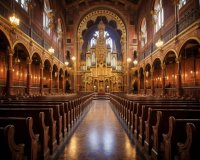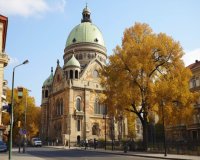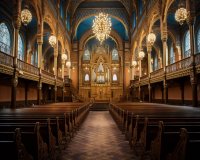The Significance of the Kazinczy Synagogue in Budapest

The Significance of the Kazinczy Synagogue in Budapest
The Kazinczy Synagogue, located in the heart of Budapest, stands as a testament to the rich cultural and historical tapestry of the city. Constructed in the 20th century, this architectural gem holds profound significance for both the Jewish community and the broader Hungarian society.
One of the distinctive features of the Kazinczy Synagogue is its unique blend of architectural styles. The facade reflects a harmonious mix of Art Nouveau and Moorish influences, creating a visually striking and culturally resonant structure. The intricate details and ornate decorations pay homage to the artistic traditions of the Jewish community, making it a captivating landmark in Budapest's cityscape.
Historically, the Kazinczy Synagogue has played a pivotal role in the preservation of Jewish heritage in Hungary. As a place of worship and community gatherings, it has served as a focal point for religious ceremonies, cultural events, and social interactions among the Jewish population. The synagogue's interior, adorned with elaborate motifs and symbols, provides a spiritual sanctuary for those who visit.
During various periods of Hungary's tumultuous history, the Kazinczy Synagogue bore witness to the challenges faced by the Jewish community. From the turbulence of the World Wars to the struggles for religious freedom, the synagogue stands resilient, embodying the endurance of a community that has contributed significantly to the cultural mosaic of Budapest.
Today, the Kazinczy Synagogue continues to be a vibrant center for Jewish life and culture. Visitors are welcomed not only to admire its architectural grandeur but also to engage with the rich cultural programs and educational initiatives hosted within its walls. The synagogue serves as a bridge between the past and the present, fostering an understanding of the historical and cultural threads that have shaped Budapest's identity.
Architectural Splendor and Cultural Heritage
The architectural splendor of the Kazinczy Synagogue is evident in its meticulous design and attention to detail. The interior features a central nave adorned with colorful stained glass windows, depicting scenes from Jewish history and tradition. The bimah, where the Torah is read, takes center stage, surrounded by intricately carved wooden elements that showcase the craftsmanship of the artisans who contributed to its creation.
Surrounding the synagogue, the Kazinczy Street area has evolved into a vibrant cultural hub, with numerous cafes, art galleries, and cultural institutions. This transformation reflects the resilience of the neighborhood and its ability to adapt while preserving its historical roots. The synagogue, with its majestic presence, stands as a guardian of this cultural legacy.
A Symbol of Religious Tolerance
Beyond its architectural and cultural significance, the Kazinczy Synagogue serves as a symbol of religious tolerance and coexistence. In a world often marked by divisions, this place of worship stands as a testament to the possibility of harmony among different faiths and communities. It encourages dialogue, understanding, and mutual respect, fostering a sense of unity in diversity.
In conclusion, the Kazinczy Synagogue in Budapest is more than a mere architectural marvel; it is a living testament to the resilience of the Jewish community and a symbol of Budapest's diverse cultural heritage. Its significance extends beyond religious boundaries, serving as a beacon of tolerance and a reminder of the shared history that binds us all.
Budapest: The Great Synagogue Skip the Line Ticket
Experience a journey through history with a skip-the-line ticket to Budapest's Great Synagogue, the largest in Europe and second-largest globally. Delve into the poignant story of Hungarian Jews before and after WWII through a guided tour.
Explore the synagogue's grounds, paying homage at the Emmanuel Memorial Tree and Raoul Wallenberg Memorial Park. Visit the Heroes’ Temple, the graveyard, and the Jewish Museum. Continue your immersion at the Hungarian Jewish Museum, featuring a unique blend of Romantic and Moorish architectural elements.
Learn about the daily lives of Hungarian Jews through their personal objects, and be moved by the Emmanuel Memorial Tree's metal leaves, each bearing the name of a Holocaust victim. Conclude your visit at the Heroes’ Temple graveyard, the resting place of those who perished in the WWII ghetto.
Highlights
- Visit the Great Synagogue, the largest in Europe
- Skip-the-line entry for an uninterrupted experience
- Explore the Emmanuel Memorial Tree and Raoul Wallenberg Memorial Park
- Guided tour of the Synagogue, Heroes’ Temple, and more
Meeting Point
Present your voucher directly at the security check at Dohány Street Synagogue.
Important Information
- The Synagogue is closed on Saturdays and Jewish holidays
- Please dress respectfully (no sleeveless tops, short skirts, or shorts)
- Men must cover their heads; a kippah is provided at the entrance
- Backpacks larger than hand luggage are not allowed
- No eating, drinking, or smoking on the premises
- Face masks are recommended but not mandatory
- Ticket office and entrance close one hour before visiting hours end
From $24.98 per person
Check availability and make this historic journey a part of your Budapest experience.
Reviews
Overall Rating: 4.4/5 based on 3357 reviews
Guide: 4.3/5 | Value for Money: 4/5 | Service: 4.4/5 | Organization: 4.3/5
Read what travelers have to say:
Superb tour with poignant and often amusing anecdotes from the guides. Easy to join any guide as they rotate between the interior of the synagogue and the garden in multiple languages. Loads to see and read. In this beautiful building you can learn about the history of Budapest, European Jewry and the shocking ways humans can and have treated each other. It’s also an incredibly hopeful place filled with light and peace.
- Michelle, United Kingdom
Tour itself was guide was knowledgeable. However, at the end of the tour, I did not appreciate it when he offered his wife’s business card to learn more about genealogy, and mention that he does private tours as well. He should I be privately promoting himself and his wife.
- Eric, United States
It wasn't really a tour as such, we sat in the main synagogue a guy chatted to us telling a brief bit about the synagogue while there were 3/4 other guides chatting to their parties, it was a bit all over the place. Then we went out to the memorial garden. And 5 or 10 mins chat later and the tour was over. The rooms were you read everything yourself about the Holocaust were very moving, that's definitely worth a visit. The photos were harrowing but a must see. And the 'gift shop' is in a really bad spot, it was like spaghetti junction trying to get through to a tiny little place. It was all a bit hap hazard if you ask me. Tho the synagogue itself is beautiful inside and out, but it's definitely not worth the money.
- Simone, United Kingdom
History and Origin of the Synagogue in Budapest
The history of the Synagogue in Budapest is a fascinating journey that reflects the rich cultural tapestry of Hungary and the resilience of the Jewish community. Synagogues, as places of worship and community gathering, have played a crucial role in the lives of Jewish people throughout history.
One of the most iconic synagogues in Budapest is the Great Synagogue, also known as Dohány Street Synagogue. Constructed in the mid-19th century, it stands as a testament to the thriving Jewish community that once flourished in the heart of Hungary.
The architectural marvel of the Great Synagogue is attributed to the collaboration between the Viennese architect Ludwig Förster and Frigyes Feszl, a Hungarian architect. The design reflects a unique blend of Moorish, Romantic, and Gothic elements, creating a visually stunning and culturally significant structure.
The Great Synagogue's construction coincided with a period of renewed Jewish identity and cultural expression in Hungary. The Jewish community sought to establish a symbol of their heritage and faith, leading to the creation of this grand edifice.
During its early years, the Great Synagogue served not only as a religious center but also as a hub for cultural and social activities. It housed a school, a library, and administrative offices, fostering a sense of community cohesion among the Jewish residents of Budapest.
The Great Synagogue and its Cultural Significance
As a cultural landmark, the Great Synagogue in Budapest has witnessed significant events and changes over the decades. It weathered the storms of World War II, during which Hungary, like many European countries, faced the horrors of the Holocaust. The synagogue and its surroundings became a poignant reminder of the struggles and resilience of the Jewish community during those dark times.
After the war, efforts were made to restore and preserve the Great Synagogue as a symbol of hope and continuity. The restoration process aimed not only to repair physical damages but also to revive the cultural and spiritual essence of the synagogue.
Today, the Great Synagogue stands as one of the largest synagogues in the world, attracting visitors from various cultural backgrounds. Its significance extends beyond religious boundaries, serving as a bridge between different communities and fostering intercultural understanding.
The Synagogue Complex and its Features
The Great Synagogue complex is not limited to the main sanctuary. It includes the Jewish Museum, a Memorial Garden, and the Raoul Wallenberg Holocaust Memorial Park. Each component adds layers to the historical narrative encapsulated within the synagogue's walls.
The Jewish Museum preserves and showcases artifacts that highlight the rich history and traditions of Hungarian Jewry. It provides a comprehensive view of Jewish life, customs, and contributions to Hungarian society throughout the centuries.
The Memorial Garden and Raoul Wallenberg Holocaust Memorial Park are poignant spaces dedicated to commemorating the lives lost during the Holocaust. These areas serve as reminders of the atrocities of the past and emphasize the importance of promoting tolerance and understanding in the present and future.
Conclusion
In conclusion, the history and origin of the Synagogue in Budapest, particularly the Great Synagogue, encapsulate a narrative of faith, resilience, and cultural vibrancy. This architectural masterpiece stands not only as a place of worship but also as a living testimony to the enduring spirit of the Jewish community in Hungary.
As visitors explore the halls of the Great Synagogue, they embark on a journey through time, gaining insights into the challenges faced by the Jewish community and the triumph of preserving identity against all odds. The Synagogue in Budapest remains a symbol of cultural heritage and a beacon of hope for future generations.
Budapest: Festive & Jewish Quarter Self-Guided Walking Tour
Explore the vibrant Jewish quarter of Budapest with a self-guided walking tour that unveils the district's rich history and contemporary cultural scene. Using your smartphone as a guide, embark on a 1.5-hour journey through the heart of the city.
About this activity
Discover the charm of the 7th District, known for its ruin bars, historic landmarks, and the impressive Dohány Street Synagogue – Europe's largest synagogue. The tour begins on the elegant Andrassy Avenue, often referred to as the "Champs Élysées" of Budapest, a UNESCO World Heritage Site.
As you stroll through the streets, your smartphone will provide audio guidance, narrating stories and anecdotes. Highlights include passing by the House of Terror, exploring the Jewish quarter, and visiting the largest synagogue in Europe. Gain insights into the district's history, from the communist era to its current status as a hub for cultural and artistic events.
Customize your itinerary, take breaks at local establishments, and resume the tour at your own pace. The tour concludes at the iconic Szimpla Kert, the city's most famous ruin bar.
Highlights
- Walk along Andrassy Avenue, Budapest's iconic boulevard
- Visit Dohány Street Synagogue, the largest synagogue in Europe
- Explore the 7th District, known for its ruin bars and cultural events
- Learn about Budapest's history, from the communist period to the present
- End the tour at Szimpla Kert, the renowned ruin bar
Includes
1.5-hour audio-guided walking tour of the old Jewish quarter and the current festive district of the city.
Meeting Point
To start your tour, visit Rewind Activation, enter your reservation number and email, then download the Rewind application. Begin the tour by clicking play at the starting point.
Important Information
- An internet connection is required for the tour duration
- Use the Rewind app on your smartphone for an immersive experience
- Recommended to bring headphones for better audio quality
- The tour is available in English, French, and Hungarian
- Pause and resume the tour at your convenience
Embark on a captivating journey through Budapest's Jewish quarter, blending history, culture, and contemporary vibes in a self-guided exploration.
The Architecture and Details of the Synagogue in Budapest
The city of Budapest, Hungary, is home to several remarkable landmarks, and among them stands the awe-inspiring Synagogue. This magnificent structure is not only a place of worship for the Jewish community but also a symbol of rich cultural heritage and architectural excellence. In this article, we will delve into the architecture and intricate details that make the Synagogue in Budapest a true masterpiece.
Historical Significance
The Synagogue, also known as the Great Synagogue or Dohány Street Synagogue, holds the distinction of being one of the largest synagogues in the world. It was built in the mid-19th century, between 1854 and 1859, during the reign of Emperor Franz Joseph I. The architectural design reflects a unique blend of different styles, making it a captivating piece of history.
Architectural Style
The Synagogue in Budapest features a combination of architectural styles, including Moorish, Romantic, and Gothic Revival elements. The exterior is adorned with intricate details, domes, and decorative motifs that showcase the Moorish influence. The use of horseshoe arches, colorful tiles, and ornate patterns adds to its distinctive character.
As you approach the Synagogue, you'll be struck by its grand facade, featuring two soaring towers and a central rose window. The towers are crowned with onion-shaped domes, creating a mesmerizing silhouette against the Budapest skyline.
Interior Splendor
Stepping inside, visitors are greeted by a breathtaking interior that seamlessly marries the Moorish and Romantic styles. The high, vaulted ceilings are adorned with intricate stucco work and delicate frescoes. A massive organ graces the western wall, while the Torah ark, a central element in any synagogue, is a masterpiece of craftsmanship.
The Synagogue's interior is also known for its stunning use of color. Stained glass windows filter sunlight through a spectrum of hues, casting a warm and inviting glow throughout the space. The play of light and shadow creates a serene and spiritual atmosphere, making it a place of deep reverence.
The Holocaust Memorial
Adjacent to the Synagogue, you'll find the Holocaust Memorial Garden, a somber reminder of the tragic events of the Holocaust. The garden features a weeping willow tree sculpture with the names of Holocaust victims inscribed on each leaf. It serves as a poignant tribute to the lives lost during that dark period in history.
Visitor Experience
Today, the Synagogue in Budapest not only serves as a place of worship but also as a popular tourist attraction. Visitors from around the world come to admire its architectural grandeur, learn about Jewish history, and pay their respects at the Holocaust Memorial.
Guided tours are available, providing in-depth insights into the history and significance of the Synagogue. Exploring the surrounding Jewish Quarter further enriches the experience, with its vibrant culture, kosher restaurants, and historic sites.
Conclusion
In conclusion, the Synagogue in Budapest is a testament to the enduring spirit of the Jewish community and a masterpiece of architectural design. Its blend of Moorish, Romantic, and Gothic Revival elements, coupled with its historical significance, makes it a must-visit destination for anyone traveling to Budapest. Whether you seek spiritual solace or architectural inspiration, this iconic landmark offers a profound and unforgettable experience.







